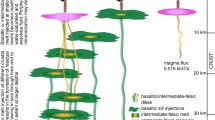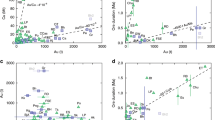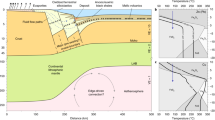Abstract
Because of the decreasing discovery rate of outcropping mineral deposits, quantitative estimates of undiscovered deep mineral resources are of great interest to many stakeholders, including governments, businesses, and researchers. Molybdenum (Mo) plays a crucial role in modern societies worldwide by contributing to infrastructure, technology, and lifestyles. In this paper, we present an up-to-date age–frequency compilation of globally reported porphyry Mo resources and we used the tectonic diffusion model to estimate the potential Mo resources at different depths in continental crust and according to different tectonic settings. Our modeling indicated that, between 300 Ma and the present, about 5,600 porphyry Mo deposits and Mo-rich porphyry copper deposits were formed worldwide. About 70% of those with ~ 1.1 × 109 tons (t) of Mo resources remain, buried and at the surface, whereas ~ 30% have been destroyed through uplift and erosion. In detail, the results suggest that ~ 2.9 × 108 t of Mo resources exist within the continental crust above ~ 3 km. Exposed deposits currently compose only ~ 7% of the endowment of porphyry Mo resources during the Phanerozoic.


available at https://github.com/myscren/Global-PMDs-compilation)






Similar content being viewed by others
Data Availability
The compiled dataset is available at https://github.com/myscren/Global-PMDs-compilation, and the computation program (Python) used in this study can be requested through e-mail from gxchen@cug.edu.cn.
References
Abrahami, R., Beek, P., Huyghe, P., et al. (2016). Decoupling of long-term exhumation and short-term erosion rates in the Sikkim Himalaya. Earth and Planetary Science Letters, 433, 76–88.
Agterberg, F. P. (1989). Computer programs for mineral exploration. Science, 245(4913), 76–82.
Ali, B., Aref, S., Elena, C., et al. (2021). One-step random-walk process of nanoparticles in cement-based materials. Journal of Central South University, 28(6), 1679–1691.
Audétat, A., & Li, W. (2017). The genesis of Climax-type porphyry Mo deposits: Insights from fluid inclusions and melt inclusions. Ore Geology Reviews, 88, 436–460.
Calas, G. (2017). Mineral resources and sustainable development. Elements, 13, 301–306.
Carranza, E. J. M. (2008). Geochemical anomaly and mineral prospectivity mapping in GIS. Elsevier.
Carten, R. B., White, W. H., & Stein, H. J. (1993). High-grade granite-related molybdenum systems: Classification and origin. Geological Association of Canada, Special Papers, 40, 521–554.
Chen, G., & Cheng, Q. (2016). Singularity analysis based on wavelet transform of fractal measures for identifying geochemical anomaly in mineral exploration. Computers & Geosciences, 87, 56–66.
Chen, G., & Cheng, Q. (2018). Fractal–based wavelet filter for separating geophysical or geochemical anomalies from background. Mathematical Geosciences, 50(3), 249–272.
Chen, G., Huang, N., Wang, D., Luo, L., & Cheng, Q. (2022). Mineral prospectivity mapping based on wavelet neural network and monte carlo simulations: A case study from nanling W-Sn metallogenic province. Ore Geology Reviews. https://doi.org/10.1016/j.oregeorev.2022.104765
Chen, Y., Wang, P., Li, N., et al. (2017). The collision-type porphyry Mo deposits in Dabie Shan, China. Ore Geology Reviews, 81, 405–430.
Cheng, Q. (2008). Non–linear theory and power–law models for information integration and mineral resources quantitative assessments. Mathematical Geosciences, 40(5), 503–532.
Cheng, Q. (2012). Singularity theory and methods for mapping geochemical anomalies caused by buried sources and for predicting undiscovered mineral deposits in covered areas. Journal of Geochemical Exploration, 122, 55–70.
Cooke, D. R., Hollings, P., & Walshe, J. L. (2005). Giant porphyry copper deposits: Characteristics, distribution, and tectonic controls. Economic Geology, 100, 801–818.
Cui, S. (1999). On global meso Cenozoic intracontinental orogenesis and orogenic belts. Earth Science Frontiers, 283–293. (in Chinese with English abstract).
Dicken, C. L., Dunlap, P., Parks, H. L., et al. (2016). Spatial database for a global assessment of undiscovered copper resources. In U.S. Geological Survey Scientific Investigations Report 2010–5090–Z (p. 29).
Ding, Q., & Yin, X. (2017). Research survey of differential evolution algorithms. CAAI Transactions on Intelligent Systems, 12, 431–442. (in Chinese with English abstract).
Dong, Y., Chawla, N. V., & Swami, A. (2017). Metapath2Vec: Scalable representation learning for heterogeneous networks. In Proc of the 23rd ACM SIGKDD Int Conf on Knowledge Discovery and Data Mining, New York: ACM (pp. 135–144).
Gasparini, N. M., & Whipple, K. X. (2014). Diagnosing climatic and tectonic controls on topography: Eastern flank of the northern Bolivian Andes. Lithosphere, 6, 230–250.
Gochioco, L. M. (2004). Introduction to this special section: Deep exploration. The Leading Edge, 23(12), 1269.
Gonzalez-Alvarez, I., Boni, M., & Anand, R. R. (2016). Mineral exploration in regolith-dominated terrains: Global considerations and challenges. Ore Geology Reviews, 73, 375–379.
Gonzalez-Alvarez, I., Goncalves, M. A., & Carranza, E. J. M. (2020). Introduction to the special issue challenges for mineral exploration in the 21st century: Targeting mineral deposits under cover. Ore Geology Reviews, 126, 103785.
Guilbert, J. M., & Park, J. C. F. (2007). The geology of ore deposits. Waveland Press.
Henckens, M. L. C. M., Driessen, P. P. J., & Worrell, E. (2018). Molybdenum resources: Their depletion and safeguarding for future generations. Resources, Conservation and Recycling, 134, 61–69.
Hou, Z., & Cook, N. (2009). Metallogenesis of the Tibetan Collisional Orogen: A review and introduction to the special issue. Ore Geology Reviews, 36, 2–24.
Hou, Z., Du, A., Wang, S., & Qu, X. (2004). Re-Os age of porphyry copper deposits associated NS-striking normal faulting system on the Tibet from molybdenites. Science in China, 47, 221–231.
Ibe, O. (2013). Markov processes for stochastic modeling. Newnes.
Kesler, S. E., & Wilkinson, B. H. (2006). The role of exhumation in the temporal distribution of ore deposits. Economic Geology, 101, 919–922.
Kesler, S. E., & Wilkinson, B. H. (2008). Earth’s copper resources estimated from tectonic diffusion of porphyry copper deposits. Geology, 36, 255–258.
Kesler, S. E., & Wilkinson, B. H. (2009). Resources of gold in phanerozoic epithermal deposits. Economic Geology, 104, 623–633.
Larsen, I. J., Montgomery, D. R., & Greenberg, H. M. (2014). The contribution of mountains to global denudation. Geology, 42, 527–530.
Leng, C., Cooke, D. R., Hou, Z., et al. (2018). Quantifying exhumation at the giant Pulang porphyry cu-au deposit Using U-Pb-He dating. Economic Geology, 113, 1077–1092.
Li, C., & Liao, R. (2020). Formation mechanism and geochemical process of porphyry molybdenum deposits. Acta Petrologica Sinica, 36, 77–84. (in Chinese with English abstract).
Ling, M., Wang, F., Ding, X., Hu, Y., et al. (2009). Cretaceous ridge subduction along the Lower Yangtze River belt, Eastern China. Economic Geology, 104, 303–321.
Ludington, S., & Plumlee, G. S. (2009). Climax-Type Porphyry Molybdenum Deposits. In U.S. Geological Survey Open-File Report 2009–1215 (p. 16).
Meinert, L. (1997). Igneous petrogenesis and skarn deposits. Mineral Deposit Modeling (pp. 569–564).
Muller, R. D., Seton, M., Zahirovic, S., et al. (2016). Ocean basin evolution and global - scale plate reorganization events since Pangea breakup. Annual Review of Earth and Planetary Sciences, 44, 107–138.
Osborne, M. F. M. (1959). Brownian motion in the stock market. Operations Research, 7(2), 145–173.
Schodde, R. (2014). The Global Shift to Undercover Exploration-How fast? How effective. In Society of Economic Geologists 2014 Conference (pp. 1–47).
Sekerin, V., Dudin, M., Gorokhova, A., et al. (2019). Mineral resources and national economic security: Current features. Mining of Mineral Deposits, 13, 72–79.
Sengör, A. M. C. (1987). Tectonics of the Tethysides: Orogenic collage development in a collisional setting. Annual Review of Earth and Planetary Sciences, 15, 213–244.
Sillitoe R. H. (1998). Major regional factors favoring large size, high hypogene grade, elevated gold content and supergene oxidation and enrichment of porphyry copper deposits. In Porphyry and hydrothermal copper and gold deposits: A global perspective (pp. 21–34).
Sinclair, W., & Goodfellow, W. (2007). Porphyry deposits. Mineral Deposits of Canada: A Synthesis of Major Deposit-Types, District Metallogeny, the Evolution of Geological Provinces, and Exploration Methods: Geological Association of Canada, Mineral Deposits Division, Special Publication, 5, 223–243.
Singer, D. A., Berger, V. I., & Moring, B. C. (2008). Porphyry copper deposits of the world: Database and grade and tonnage models. In USGS Open-File Report 2008–1155.
Singer, D. A., Jaireth, S., & Roach, I. (2018). A three-part quantitative assessment of undiscovered unconformity-related uranium deposits in the Pine Creek region of Australia. In Iaea Tecdoc Series (p. 350).
Singer, D. A. (1993). Basic concepts in three-part quantitative assessments of undiscovered mineral resources. Nonrenewable Resources, 2, 69–81.
Singer, D. A. (2007). Mineral deposit densities for estimating mineral resources. Mathematical Geosciences, 40, 33–46.
Singer, D. A., & Kouda, R. (2011). Probabilistic estimates of number of undiscovered deposits and their total tonnages in permissive tracts using deposit densities. Natural Resources Research, 20, 89–93.
Singer, D. A., & Menzie, W. D. (2010). Quantitative mineral resource assessments: An integrated approach. Oxford University Press.
Storn, R., & Price, K. (1997). Differential evolution–a simple and efficient heuristic for global optimization over continuous spaces. Journal of Global Optimization, 11(4), 341–359.
Sun, W., Li, C., Ling, M., et al. (2015). The geochemical behavior of molybdenum and mineralization. Acta Petrologica Sinica, 31, 1807–1817. (in Chinese with English abstract).
Taylor, R. D., Hammarstrom, J. M., Piatak, N. M., et al. (2010). Arc-related porphyry molybdenum deposit model: Chapter D in Mineral deposit models for resource assessment. U.S. Geological Survey Scientific Investigations Report 2010–5070-D, 64.
Veizer, J., & Jansen, S. L. (1979). Basement and sedimentary recycling and continental evolution. The Journal of Geology, 87, 341–370.
Wan, X., & Sun, X. (2021). Apatite fission track thermochronology of Cenozoic igneous rocks from porphyry copper deposits in the Gangdese belt of southern Tibet: Implications for cooling history and ore preservation. Ore Geology Reviews, 133, 104075.
Whipple, K. X., & Gasparini, N. M. (2014). Tectonic control of topography, rainfall patterns, and erosion during rapid post–12 Ma uplift of the Bolivian Andes. Lithosphere, 6, 251–268.
Wilkinson, B. H., & Kesler, S. E. (2007). Tectonism and exhumation in convergent margin orogens: Insights from ore deposits. Journal of Geology, 115, 611–627.
Wilkinson, B. H., & Kesler, S. E. (2010). Tectonic-diffusion estimate of orogenic gold resources. Economic Geology, 105, 1321–1334.
Willenbring, J. K., Codilean, A. T., & Mcelroy, B. (2013). Earth is (mostly) flat: Apportionment of the flux of continental sediment over millennial time scales. Geology, 41, 343–346.
Wu, F., Xu, Y., Gao, S., et al. (2008). Lithospheric thinning and destruction of the North China Craton. Acta Petrologica Sinica, 24, 1145–1174. (in Chinese with English abstract).
Wu, Y., Chen, Y., Li, N., et al. (2017). Mo deposits in Northwest China: Geology, geochemistry, geochronology and tectonic setting. Ore Geology Reviews, 81, 641–671.
Yang, Q., Cai, L., & Xue, Y. (2008). A survey of differential evolution algorithms. Pattern Recognition and Artificial Intelligence, 21, 506–513. (in Chinese with English abstract).
Yanites, B., & Kesler, S. (2015). A climate signal in exhumation patterns revealed by porphyry copper deposits. Nature Geosci, 8, 462–465.
Zhang, Q., Jin, W., Wang, Y., et al. (2006). A model of delamination of continental lower crust. Acta Petrologica Sinica (pp. 265–276). (in Chinese with English abstract).
Zhao, P., Chen, J., & Chen, J. (2001). Introduction to “Three step” digital mineral prospecting and assessment. In Proceedings of the International Symposium (pp. 1–5).
Zhao, J., Qin, K., Xiao, Bo., et al. (2016). Thermal history of the giant Qulong Cu-Mo deposit, Gangdese metallogenic belt, Tibet: Constraints on magmatic-hydrothermal evolution and exhumation. Gondwana Research, 36, 390–409.
Zhou, A., Dai, J., Li, Y., et al. (2019). Differential exhumation histories between Qulong and Xiongcun porphyry copper deposits in the Gangdese copper metallogenic belt: Insights from low temperature thermochronology. Ore Geology Reviews, 107, 801–819.
Zuo, R., Wang, J., Xiong, Y., et al. (2021). The processing methods of geochemical exploration data: past, present, and future. Applied Geochemistry, 132, 105072.
Zuo, R., Xiong, Y., Wang, J., et al. (2019). Deep learning and its application in geochemical mapping. Earth-Science Reviews, 192, 1–14.
Acknowledgments
This research was jointly supported by the National Natural Science Foundation of China (Nos. 41972305, 42172331, and 42050103). Thanks are due to B.H. Wilkinson, John Carranza, and three anonymous reviewers for their comments that helped us improve this paper greatly.
Author information
Authors and Affiliations
Corresponding author
Rights and permissions
About this article
Cite this article
Luo, L., Chen, G. & Xia, Q. Tectonic Diffusion Estimates of Global Porphyry Molybdenum Resources. Nat Resour Res 31, 751–766 (2022). https://doi.org/10.1007/s11053-022-10024-z
Received:
Accepted:
Published:
Issue Date:
DOI: https://doi.org/10.1007/s11053-022-10024-z




